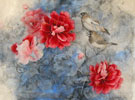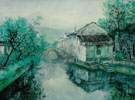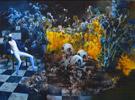Reproducing the Nature
by Zhu Yuze
Appreciate Mr. Lu Lin’s introducing, I met Mr. Li Guangming again. Few months ago, I came to his studio and found his new water and ink series created in recent years. This time, we had a long talk. In the conversations I always thinked and tried to speculate the wide art realm of Mr.Li Guangming. This new water and ink series are mainly based on the creation process of melting inky ice sculpture. Our exploration of Chinese ink has similar direction, so we talked freely and flowingly. We both felt it was so late for us to meet each other.
Today, art has been enslaved. So many artists are trying their best to copy their established works. Is there anyone who still thinks about art, and even the future of Chinese ink? No. This phenomenon has directly contributed to the destruction of Chinese painting. Now Chinese paintings have become craft, because it lost the essence of art. So there is no reason to reach noble and pure again. However, Mr. Li Guangming gave up his adept art style to explore the essence of ink paintings. This is brave that should be inherent in all artists, but not the characterless one. Just the braveness helps him to achieve his creation on Chinese ink art. The meaning of art life for artists is to create, it is not only the highest pursuit but also the ultimate value.
In the 21st century China will gradually farewell the age of agriculture, and move to industrial and post-industrial age sequentially. We could believe China will step with the world on economy and culture. By the influence of high speed development on economy, Chinese culture is on the process of revolution. Today’s China is undergoing a very complicated phase that never happens before. Now, it is the Cultural interchange period.
How to explore under upholding the spirit of Chinese ink art, it appeared various experiments around the 30 years after reform and openness. Especially abstract ink painting, it presents greatest impact on one’s visual and inertia mental. However, true abstract ink art has been achieved just in the past few years, which gets rid of traditional artistic conception. I think the abstract ink should be put aside the entire traditional bound of brush and ink, but in pursuit of ink spirit. Abstract ink seems to explore the beauty of ink material in the visual form and to find its own rhythm of water and ink. In fact, it is the exploration in spiritual and philosophical propositions. All with a hint of form are not pure abstract ink. On philosophical field, abstract ink is beyond subject-object dichotomy, beyond time and space. Differently, Abstract ink is neither to represent objective world, nor to performance subjective consciousness, it is "post-philosophy" which means pursuit of spirit that can go beyond subject and object. Abstract ink art should return to psychological space and deviate from visual forms, it goes through the pursuit of the screen form and composition to reach the pursuit of spirit of ink.
Western philosophers came up with a new definition of philosophy in 1970s, which surpasses rather than abandons traditional philosophy. In fact Karl Marx said that philosophy should be culminated during his last years. Particularly in his Introduction to the Critique of Hegel’s Philosophy, Karl Marx declared his siding with "di-philosophy". Obviously what he disapproved of was the philosophy in traditional definition. Against dividing subjects from objects, "Post-philosophy" fortifies the idea of integrating man with the world, which accords with the philosophy of unity of heaven and man in Daoism.
Mr. Li Guangming’s latest Ink series is bright, smooth and tense, expressing the naturalness of "Dao". In what manner should man treat nature concerns not only philosophers but also minded artists including Mr. Li. He talked about Taoistic Thought Emulates Nature, so an artist reflects on philosophy, while a painter would not necessarily do so. Mr. Li said that he is appealing for respect for nature and has spent many years to explore his artistic way of expressing Dao. At the meantime, he is confident in applying uncertainty of symbols, intransitiveness of language and natural artistic strokes to creating "Second Nature", which resembles the beauty of "First Nature" more than otherwise. So he is against setting subject before creating.
As industrializing goes on, the antagonism between man and nature becomes severer. Since the second half of the 20th century, ecology philosophy and ecology aesthetics have emerged one after another. They have overturned the basic paradigm of nature defined by traditional philosophy. In their view, separating subject from object is doomed to die. They are against man-oriented values and calls for a brand-new ecological value system. In such system, man is a part of nature, which is a net of existence and life chain formed by interdependent parts, so nothing can be extracted intact from within. Pretentiously self-important man reconsiders his relationship with man. Nature is no longer reduced to an object to be recreated, harnessed or fought against; instead it is fairly treated with respect. Ecology aesthetics takes the relationship between man and nature as its subject, and nature is regarded as a free living being with its own values including aesthetic value, so does every part of nature. And even tiny as pollen has its noble reasons for existence, for after falling into soil, it will grow indomitably and come into flower. That coheres with philosophy of Daoism and Chan Buddhism. A Buddhist term goes, “a flower is a world, and a leaf is a Bodhi.”
Mr. Li’s latest Ink work just represents the value system of ecology aesthetics. He began with contemplating how to remove form and color of a subject and extract the essential regulation of material world. True Abstraction artists would build up his knowledge and taste through philosophical and aesthetic study first, rather than randomly withdrawing nonsense. French artist Charles Pierre Baudelaire who recognized that point early concluded that an aesthetic mind consists of self-discipline and innovating ability. He culminated previous proposition that virtue and beauty go hand in hand, and freed esthetics from moral standards. In a letter to his mother, he wrote that he had been insisting that pursue of literature and art has nothing to do with morality, for the beauty of composition and style would have fulfilled him.
The mainstream in China never quite understands why abstract art has to go abstract yet keeps on striking at abstraction. Reasons are many, and the most significant one is academic division in philosophy and aesthetics. It is acknowledged that the earliest abstraction blow on western esthetics was made by Wilhelm Worringer, a German art historian who is best known for his doctoral thesis, Abstraction and Empathy. In it he argued that there were two main kinds of art impulse: "empathy" and "abstraction". He wrote, "The original artistic impulse has nothing to do with imitation of nature. This impulse is in search of pure abstraction as the sole possibility of finding rest amidst the confusion and obscurity of the image of the world, and it creates a geometric abstraction starting with itself, in a purely instinctive manner. It is the realized expression, and the sole expression conceivable for man, of the emancipation from any arbitrariness and any temporality of the image of the world."
Mr. Li realizes that sticking to "Spirit of Ink" and Chinese Daoism is a necessity for improving Ink art. He manages to bring a new look to Ink art by changing the state of water, enriching color gradation and language of Ink. He freezes Ink into ice chunks of various shapes, lays them on one or several Xuan papers. Ices are left to melt naturally and patterns are formed. Also he performs the process as an art. He believes that he will find the way to improve Ink art from its origin. Ink is fine and smooth, also rich in gradation. And Xuan paper is pervious. Water helps to enlarge the gradation of Ink color. When dissolving Ink into water, you can observe delicate changes, which illustrates our nation’s unique philosophy. The media of Ink art represents Chinese culture. After dissolved into water, Ink is painted on Xuan paper, so as to produce an artwork of vitality and unique state that no other art forms resemble.
Artists are still composing and creating according to traditional philosophy, thus their works are bound by image of reality. But I am sure that restriction will be broken and new forms of expression will be erected according to artist’s subjective. In a way abstract art of Post-modernism continues that aesthetic study, which believes that image of an item is just its appearance, yet its free existence is the true meaning. According to that theory, pure abstract art is defined as non-figurative, life-like, natural reimaging of an object.
Traditional painting is "to reproduce a substance", and modern art is "expressionistic", while post-modern art aims to "reproduce nature and truth". Mr. Li initiates a new way of artistic form and idea of creating by presenting nature and generating "second nature" in his Ink work. "Second nature" is an important concept in esthetic and literature studies. Here we borrow it from the west to include Odebrecht’s “second new object” (1883—1945), Zhuangzi’s spirit of art (a great Chinese philosopher, 369BC. — 286 BC.), Chinese traditional theory of combining sensation with scenery, and so on. I think "second nature", which is also against dividing subjects from objects, has methodical significance. A painter needs to bear the rule of nature in mind, and then apply artistic performance. To reproduce nature he must observe scrupulously and study perspective, technique of light and shadow, and color theory and applications.
Martin Heidegger, the German philosopher (1889—1976), is also known as a major character in promoting a modern theory "Occurrence and Concealing", which opposes to aesthetical traditions. Heidegger said that Beauty is the "shining forth" for the "self-concealing being" in the work, and beauty is one way in which truth occurs. Thus to know is to see what is present as such, in its "unconcealed" nature, but to uncover the being which is hidden. Heidegger has influenced many artistic explorations deeply including mine and Mr. Li’s. So Mr. Li is trying to uncover the concealing being, i.e. the truth of art.
In fact, our ancestors were not conservative in creating new forms of Ink art. They experimented boldly. According to history, Mi Fu, a famous calligrapher and painter in North Song Dynasty (960 AD.-1127AD.), used paper strip, bagasse and lotus seed pot instead of brush to paint. Another rumor says after painting on silk, he washed the silk to get sketch of landscape. His son, Mi Youren, also a famous painter, held Ink in old and shabby papers to paint. Those bold trials created a new liberal style of painting, and used to bring Ink art to a new horizon. Yet painters stopped exploring in materials in South Song Dynasty (1127 AD.-1279 AD.) due to the influence of Confucianism. Wang Qia, alias Wang Mo, a legendry painter in Tang Dynasty (618 AD.-907 AD.), dipped his hair in Ink to paint. He was good at splash-ink painting and spent most of his time wandering around all corners of the country. He was a vagabond and loved drinking. He painted high-spiritedly after drinking. Legend tells that he would first splash Ink on canvas or paper, then rub, wipe, and stumble on it. Magically images of mountain, rocks, waters or trees turned out. No filthy mark was left as if the paintings were washed by clouds and rains, but unfortunately none of his works is handed down.
Not fettered by tradition, Mr. Li let Ink and Water dissolve and perform freely. His expression of spirits elevates Ink art. Western art defines abstractions as "absolute modeling", while "relative modeling" is to imitate a subject. I believe that abstract Ink can serve as a language expressing thoughts. When immaterialized and purified, it will represent truth, harmony between man and nature.
The color of Ink is abstraction of all colors, and it accords with Taoist’s plainness and simplicity. The art aims to turn to inner world to find truth, which is in the interest of Daoism. By mixing ice or water with Ink, Mr. Li lays it to melt on its carrier. It’s not a game he’s playing. What he is expressing is the “Spirit of Ink”, the value of extreme clarity in a unique way of creating.
Benedictus Spinoza, a Dutch philosopher, says all provisions are negative. Chinese Ink art is currently facing a true revolution, I believe traditional definitions, patterns, techniques and words will be renewed. Ink art has got to evolve. It will become conceptual and philosophical rather than reproducing a substance or reality. As society is informationized, Ink art must keep up its pace with the time and satisfy audience visually and spiritually. It will unfold man’s spirit, sensation, ideology, understanding and imagination, and let the others get the true meaning of art. I wish Mr. Li and his new Ink art a brilliant future.
Oct. 2010 Beijing




